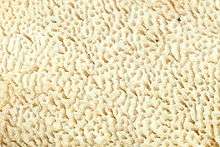Cerrena unicolor
| Cerrena unicolor | |
|---|---|
 | |
| Scientific classification | |
| Kingdom: | Fungi |
| Division: | Basidiomycota |
| Class: | Agaricomycetes |
| Order: | Polyporales |
| Family: | Polyporaceae |
| Genus: | Cerrena |
| Species: | C. unicolor |
| Binomial name | |
| Cerrena unicolor (Bull.) Murrill (1903) | |
| Synonyms | |
Cerrena unicolor, commonly known as the mossy maze polypore,[1] is a species of fungus in the genus Cerrena (Family: Polyporaceae). This saprobic fungus causes a white rot.
Description
Cerrena unicolor has fruit bodies that are semicircular, wavy brackets up to 10 centimeters (4 in) wide.[1] Attached to the growing surface without a stalk (sessile), the upper surface is finely hairy, white to grayish brown in color, and in zonate—marked with zones or concentric bands of color. The surface is often green from algal growth. The pore surface is whitish in young specimens, later turning gray in maturity. The arrangement of the pores resembles a maze of slots; the tubes may extend to 4 mm deep.[2] The spore print is white.
Spore are elliptical in shape, smooth, hyaline, in amyloid, and have dimensions of 5–7 x 2.5–4 µm.[2]

Applications
Cerrena unicolor has been identified as a source of the enzyme laccase. This enzyme has potential applications in a wide variety of bioprocesses. C. unicolor is known to produce laccase in culture at more favorable conditions and in higher yield than other wood rotting fungi,[3][4] and research is focussing on ways to produce laccase cost-effectively on a large scale.[5]
External links
References
- 1 2 Roody, William C. (2003). Mushrooms of West Virginia and the Central Appalachians. Lexington, Kentucky: University Press of Kentucky. p. 370. ISBN 0-8131-9039-8. Google Books
- 1 2 "Cerrena unicolor (MushroomExpert.Com)". Retrieved 2009-01-30.
- ↑ Leonowicz A, Gianfreda L, Rogalski J, Jaszek M, Luterek J, Wojtaś-Wasilewska M, Malarczyk E, Dawidowicz A, Fink-Boots M, Ginalska G, Staszczak M, Cho N-S. (1997). "Appearance of laccase in wood-rotting fungi and its inducibility." Journal of Korean Wood Science and Technology 25: 29–36.
- ↑ Rogalski J, Dawidowicz A, Jóźwik E, Leonowicz A. (1999). Immobilization of laccase from Cerrena unicolor on controlled porosity glass. Journal of Molecular Catalysis (B: Enzymatic) 6: 29–39.
- ↑ Janusz G, Rogalski J, Szczodrak J. (2007). Increased production of laccase by Cerrena unicolor in submerged liquid cultures. World Journal of Microbiology and Biotechnology 23(10): 1459–1464.